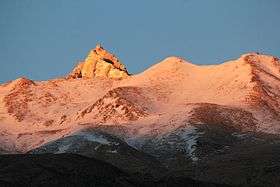Geography of Himachal Pradesh
| Area | 55,673 km² |
| State capital | Shimla |
| Language | Hindi and Pahari |
| Highest point | Shilla (7026 m) |
| Districts | 12 |
| Population | 6,864,602 (as per census 2011) |
| Literacy | 82.80% |

The state of Himachal Pradesh is spread over an area 55,673 km² and is bordered by Jammu and Kashmir on the north, Punjab on the southwest, Haryana on the south, Uttarakhand on the southeast and Tibet on the east. Himachal is a mountainous region, rich in its natural resources.
Characteristics
Elevation ranges from 450 metres to over 6,800 metres above sea level. The region extends from the Shivalik range of mountains (barely mountainous region). There is a noticeable increase in elevation from west to east and from south to north. At 7026 m Shilla is the highest mountain peak in the state of Himachal Pradesh.[1]
The general physiographic divisions from south to north are:
- The outer Himalayas (Shivaliks)
- The lesser Himalayas (central zone)
- The Great Himalayas (northern zone)
- Zanskar range (shilla Peak-kinnaur)4
The Shivalik range consists of lower hills (600 m above sea level). The hills of the region are composed of highly unconsolidated deposits which results in a high rate of erosion and deforestation.
The lesser Himalayas are spotted by a gradual elevation towards the Dhauladhar and the Pir Panjal ranges. The rise is more rapid in the Shimla hills, to the south of which is the high peak of church — Chandni (3647 m). North of the river Sutlej, the rise is steady.
The Kangra valley is a longitudinal trough which is at the foot of the Dhauladhar range. Dhauladhar (which means the 'The White Peak') has a mean elevation of nearly 4,550 metres. It has a rapid rise of 3,600 m above the Kangra valley. The largest of the lesser Himalayan ranges, the Pir Panjal, branches off from the Greater Himalayan range near the bank of the Sutlej. A number of glaciers exist and several passes lie across the Pir Panjal. The Rohtang Pass (3,978 m) is one of these.
The Great Himalayan range (5,000 to 6,000 metres) runs along the eastern boundary and is slashed across by the Sutlej. Some of the famous passes in this range are Kangla (5,248 m), Bara Lacha (4,512 m), Parang (5,548 m) and Pin Parbati (4,802 m).
The Zaskar Range, the easternmost range, separates Kinnaur and Spiti from Tibet. It has peaks up to 6,500 m high. Some of the well-known peaks are Shilla (7,026 m) and Riwo Phargyul (6,791 m); these are among the highest peaks in this range. There are many glaciers over the Zaskar and the Great Himalayan ranges.
Himachal is well known for its rich flora. Forests cover about 38% of the state's area. It has a variety of wildlife, too.
Himachal has 49 cities and towns. The smallest town is Naina Devi and the largest is Shimla with a total state population of 6,856,509. Urban population is only 7.5% of the state population. Most of the population resides in rural areas.[2]
References
| ||||||||||||||||||||

